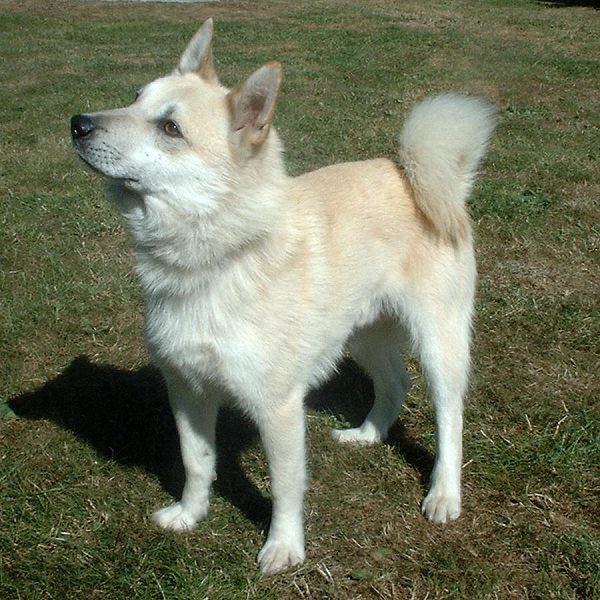Type the name of the breed you're looking for below
[wpdreams_ajaxsearchlite] Don't see the breed your're looking for? Click here and let us know!
Breed Characteristics
1 paw - breed exhibits the least amount of this characteristic
5 paws - breed exhibits most amount of this characteristic
Norwegian Buhund
| Other Names | Norsk Buhund, Norwegian Sheepdog, Nordiske Sitz-hunde |
| Country of Origin | Norway |
| Weight | Males: 31 - 40 lbs. (14 - 18 kg) Females: 26½ - 35½ lbs. (12 - 16 kg) |
| Height (at withers) | Males: 17 - 18½ in. (43 - 47 cm) Females: 16 - 17½ in. (41 - 45 cm) |
| Coat | The Norwegian Buhund has two coats. There is an outer coat that is thick and rich but lies smoothly. The under coat is soft, dense, and woolly. The coat is shorter on the head and legs but longer on the chest and neck. The males will typically have a slightly longer coat than the females. They are naturally clean dogs and are basically odorless even when wet. |
| Colour | Wheaton: This ranges from light to yellowish red. There can be dark tipped hairs and a mask. Black: Can contain white blaze, white markings on chest and ring on neck and legs. |
| Litter Size | 3 - 5 puppies |
| Life Span | 13 - 15 years |
| Origin & History | The Norwegian Buhund belongs to a large class of dogs called the Spitz type. There are many variations in size, coat and colour among the Spitz breeds. In the ancient Gokstad excavation in Norway, where a Viking grave from about the year 900 was opened, skeletons from six dogs of various sizes were found. They would be the antecedents of modern-day Buhunds. When Vikings died, their most cherished and necessary possessions were buried alongside their owners. This was to care for the Vikings in their afterlife. The dogs that protected farms and herded cattle and sheep were expected to continue these duties in Valhalla. It has been documented that these dogs travelled with Vikings on their many journeys, by sea and by land. |
| Personality | The Norwegian Buhund is vigilant, cheerful, active, untiring, intelligent and attentive. Very affectionate, it loves giving kisses and snuggling. This breed needs physical and mental stimulation and require consistent, firm leadership as it can be headstrong if it senses its handlers are not as strong minded as itself. These dogs like to be taught and learn very quickly. A natural watchdog, the Buhund is brave and vocal but not aggressive. It is unlikely to bite or snap unless provoked and led to believe it is alpha over the humans as a result of lack of leadership. Buhunds love their family and are known for their fondness of children. It is an ideal size for a house dog and a great people lover. This is a very trainable breed. The Norwegian Buhund is very active and needs a lot of exercise. It needs obedience training to establish reliable manners. If your dog tends to bark at you when it wants something it is a sign that your dog believes he is above you in the pack order, and you not only need to hush him, but you also need to reevaluate your canine to human leadership skills. A dog that believes he is alpha can be very stubborn. May try to herd humans and needs to be taught this is not acceptable. |
Care Requirements
| Health | Hip Dysplasia: A very common Degenerative Joint Disease that affects many breeds. It is the abnormal development of the hip joint in the young dog. If there are no carriers of dysplasia in the dog's lineage then the dog will not develop hip dysplasia. It is important to research the breeder's and the lineage before purchasing the dog and to use a reputable breeder whenever possible. Eye problems: Some eye problems have been mentioned, but typically Norwegian Buhunds are very healthy dogs. |
| Grooming | The Buhund has a medium to short easy-care coat that does not mat or tangle when it sheds. The coat should be brushed regularly and needs extra care during shedding season. This breed is a seasonal heavy shedder. |
| Exercise | This is a very active breed that needs to be exercised every day, with a long, brisk walk or jog. While out on the walk the dog must be made to heel beside or behind the person holding the lead, as in a dog's mind the leader leads the way, and that leader needs to be the human. In addition, they greatly enjoy sessions of play. |
| Other Considerations | The Norwegian Buhund would do best living in a house with at least a small fenced-in yard. These dogs are very active and should get plenty of chances to exercise. They can, however, live in an apartment if extra care is given for sufficient exercise and the apartment is fairly big for the dog to move around. |



